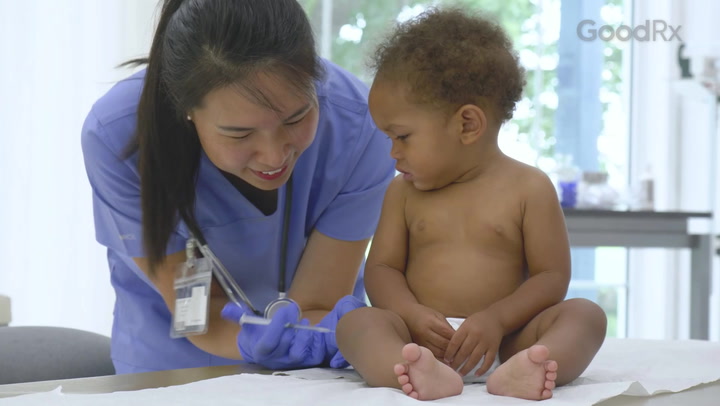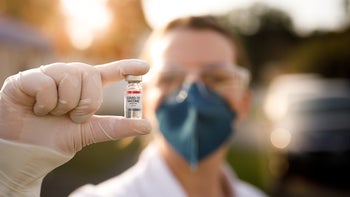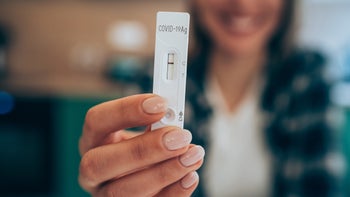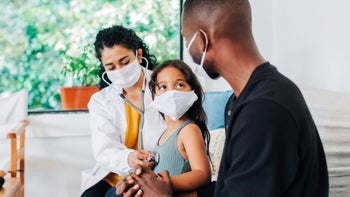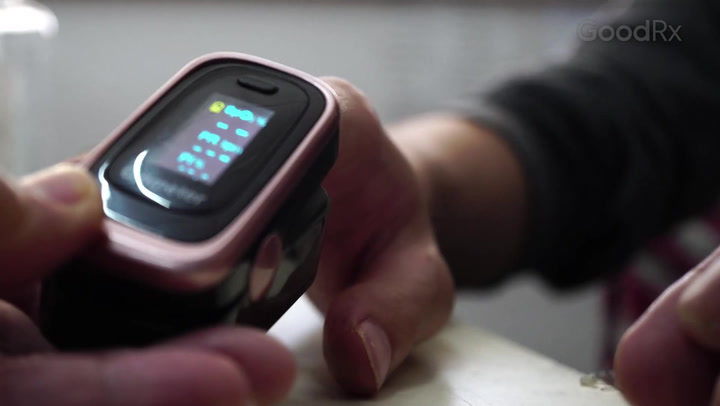
What Are the Mild Symptoms of COVID — and When Should You See a Doctor?
Key takeaways:
Mild COVID-19 means you have symptoms like a cough, sore throat, and fatigue — but no shortness of breath.
Most of the time, people can treat mild COVID infections at home.
There are specific COVID treatments for certain people, so contact your healthcare team to discuss your options.
Table of contents
Most cases of COVID-19 infection are “mild.” But the symptoms of mild COVID might not feel mild. Yes, for some, the symptoms can be easily confused with a cold or the flu (influenza). But, for many, the illness is different from anything they’ve experienced before.
So, how do you know when it’s safe to go the self-care route at home — and when it’s time to get help?
Here’s what a mild infection with the virus that causes COVID actually looks and feels like, as well as steps you can take to recover.
SHINGRIX (Zoster Vaccine Recombinant, Adjuvanted) is now $0 for almost everyone*
Get SHINGRIX at the pharmacy or in-network doctor’s office today. 98% of privately insured people pay $0 and all Medicare Part D beneficiaries pay $0 at the pharmacy.
Prescribing Information
*Coverage and cost may vary and are subject to change without notice. Reimbursement decisions are made by individual insurance plans.


SHINGRIX is an FDA-approved vaccine for the prevention of shingles (herpes zoster) in adults 50 years and older. SHINGRIX is not used to prevent chickenpox.
• You should not receive SHINGRIX if you are allergic to any of its ingredients or had an allergic reaction to a previous dose of SHINGRIX
• An increased risk of Guillain-Barré syndrome (severe muscle weakness) was observed after vaccination with SHINGRIX
• Fainting can happen after getting injectable vaccines, including SHINGRIX. Precautions should be taken to avoid falling and injury due to fainting
• The most common side effects are pain, redness, and swelling at the injection site, muscle pain, tiredness, headache, shivering, fever, and upset stomach
• SHINGRIX was not studied in pregnant or nursing women. Tell your healthcare provider if you are pregnant, plan to become pregnant, or are breastfeeding
• Vaccination with SHINGRIX may not protect all individuals
• Ask your healthcare provider about the risks and benefits of SHINGRIX. Only a healthcare provider can decide if SHINGRIX is right for you
You are encouraged to report vaccine adverse events to the US Department of Health and Human Services. Visit www.vaers.hhs.gov to file a report, or call 1-800-822-7967.
For US audiences.
Trademarks are property of their respective owners.
©️2024 GSK or licensor.
PMUS-SGXWCNT240015 May 2024
Produced in the USA.
GoodRx Health information and resources are reviewed by our editorial staff with medical and healthcare policy and pricing experience. See our editorial policy for more detail. We also provide access to services offered by GoodRx and our partners when we think these services might be useful to our visitors. We may receive compensation when a user decides to leverage these services, but making them available does not influence the medical content our editorial staff provides.
What does mild COVID feel like?
The possible symptoms of a COVID infection include:
Congestion or runny nose
Fatigue
Sneezing
Cough
Fever or chills
New loss of smell or taste
Muscle or body aches
Nausea or vomiting
But what does “mild” mean when you have COVID? If you have any of the symptoms listed above without shortness of breath or abnormal chest imaging (such as X-ray), you have a mild COVID infection, according to the World Health Organization (WHO).
Can you have COVID without a fever?
Yes, you can have COVID infection without a fever. In fact, you may have a COVID infection and not have symptoms at all.
How common is mild COVID infection?
It’s hard to say how common “mild” COVID infection is because most people are testing at home these days. Plus, public health organizations are no longer reporting confirmed cases. But data suggests that at least 8 in 10 people with a COVID infection have a mild illness that doesn’t require hospitalization.
Some people infected with COVID show no symptoms at all. These people are called “asymptomatic carriers.” This means they don’t have symptoms, but they can still spread the virus. The data on how many people are asymptomatic carriers varies widely from study to study. Some data suggests it’s as high as 60%.
All about COVID-19 vaccines: Getting vaccinated is the best way to protect yourself from infection. Learn about the updated COVID vaccines.
COVID remedies: There are lots of things you can do to ease your COVID symptoms at home.
When COVID is severe: Though most cases of COVID can be treated at home, it can cause serious illness. Learn when to go to the ER.
Why do some people only get mild COVID symptoms while others get very ill?
Some people are at higher risk for getting severe COVID. This includes people who:
Smoke
Are 50 years old or older, and especially over 65 years old
Aren’t vaccinated
Have medical conditions, such as asthma, cancer, or diabetes
Have heart, liver, or lung disease
Have certain mental health conditions or dementia
Have a body mass index (BMI) greater than 30
Aren’t physically active
Have a weakened immune system
Are pregnant, or have recently had a baby
Having more than one of these factors puts you at even higher risk of severe symptoms, if you get sick with COVID.
How to care for mild symptoms of COVID
If you think you have COVID infection, you’ll want to avoid spreading the virus to others while also taking care of yourself. These days, the CDC recommends handling a mild COVID infection similar to the way you might handle any other mild, contagious respiratory illness. That means staying away from others while you’re feeling sick.
You can treat mild symptoms — like cough, body aches, and fever — with over-the-counter flu and cold medications. Acetaminophen (Tylenol) and ibuprofen (Advil, Motrin) are safe to take for COVID infection and can help relieve your symptoms. As with any mild respiratory illness, be sure to get plenty of rest, eat nutritious foods, and stay hydrated.
Some treatments for COVID are available for certain people. If you’re at risk for severe COVID, be sure to ask your primary care provider about your options.
How long do I need to stay home if I have mild COVID?
Staying home when you have mild COVID allows you to rest and take care of yourself. It also keeps the germ from spreading. There’s no exact number of days that you need to isolate if you have mild COVID. Instead, stay home while you’re sick.
According to the CDC, you can return to your normal activities when you’ve had 24 hours of both feeling better and having no fever, without using fever-reducing medication.
However, it’s important to know that you might stay contagious with COVID for a few days after you return to your activities. During this time, you can lessen the chance of spreading the virus to others by distancing, wearing a mask, and paying careful attention to hygiene.
Can mild symptoms of COVID become severe?
Yes, mild symptoms can turn into severe symptoms. So, it’s important to track the timeline of your illness. Many people don’t get symptoms right away when they catch COVID. Sometimes symptoms take up to 14 days to show up.
Typical COVID stages and progression
Some people with COVID never have symptoms. Others continue to feel sick after 3 weeks. So, it’s hard to give an exact timeline for how your COVID infection will progress. But COVID stages and symptoms tend to follow some general patterns.
When COVID symptoms occur, they usually show up between days 2 to 5. Nasal congestion, sore throat, and cough often show up first.
Symptoms usually peak about 3 to 5 days after you begin to feel sick. You’re more likely to have fever, muscle aches, and headache during these days.
What is long COVID?
Most people with COVID infection feel better within a few weeks. But some people develop long COVID. This is a broad term that describes a wide range of health issues that start or continue 4 weeks after getting infected with the virus that causes COVID. Long COVID can occur regardless of the severity of your initial infection.
There are no specific treatments for long COVID at the moment. But there’s ongoing research to better help people with this condition.
How do you know when to see a doctor or go to the ER?
COVID illness can worsen quickly. So, it’s important to understand your risk and to know when to get help.
Get medical attention right away if you have any of the following symptoms:
New or worsening breathlessness that doesn't settle
Inability to walk around your home, shower, or dress without getting out of breath
Bluish lips or tongue
New confusion or drowsiness
These symptoms are a sign of low blood oxygen. This is the most worrying feature of COVID infection because your body needs oxygen to survive.
The virus that causes COVID can cause a double lung infection (bilateral pneumonia). When the lungs are full of infection, they can’t oxygenate blood. The lungs can’t get enough fresh air (oxygen) in, and they can’t get enough waste air (carbon dioxide) out. Before oxygen levels drop, a person with severe COVID pneumonia will start to breathe faster and deeper.
Don’t wait until your blood oxygen levels drop before getting help. A dropping blood oxygen level is a sign the pneumonia is getting worse and that your lungs are in trouble.
Also, get urgent medical attention if you have other symptoms that would usually worry you, such as:
Chest pains
Severe headaches
Seizures
Weakness in your face, arms, or legs
This was true before the COVID pandemic, and it’s still true now.
The bottom line
Mild symptoms COVID include cough, sore throat, and fatigue — but not shortness of breath. Most people can safely treat mild COVID at home with over-the-counter medications, rest, and adequate nutrition. But symptoms can worsen quickly, especially for people who are at higher risk for severe illness. Get medical attention right away if you have new or worsening breathlessness.
Why trust our experts?



References
Centers for Disease Control and Prevention. (2024). Preventing spread of respiratory viruses when you're sick.
Centers for Disease Control and Prevention. (2024). Taking steps for cleaner air for respiratory virus prevention.
Centers for Disease Control and Prevention. (2024). Trends in United States COVID-19 deaths, emergency department (ED) visits, and test positivity by geographic area.
Centers for Disease Control and Prevention. (2024). Underlying conditions and the higher risk for severe COVID-19.
Johansson, M. A., et al. (2021). SARS-CoV-2 transmission from people without COVID-19 symptoms. Journal of the American Medical Association Network Open.
John Hopkins University and Medicine. (n.d.). Mortality analyses.
Lane, A., et al. (2022). Clinical characteristics and symptom duration among outpatients with COVID-19. American Journal of Infection Control.
Menni, C., et al. (2022). Symptom prevalence, duration, and risk of hospital admission in individuals infected with SARS-CoV-2 during periods of omicron and delta variant dominance: A prospective observational study from the ZOE COVID study. The Lancet.
World Health Organization. (2023). COVID-19: Symptoms.
Wu, Y., et al. (2022). Incubation period of COVID-19 caused by unique SARS-CoV-2 strains: A systematic review and meta-analysis. Journal of the American Medical Association Network Open.


